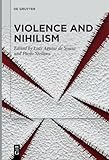Violence and Nihilism / ed. by Luís Aguiar de Sousa, Paolo Stellino.
Material type: TextPublisher: Berlin ; Boston : De Gruyter, [2022]Copyright date: ©2022Description: 1 online resource (VI, 321 p.)Content type:
TextPublisher: Berlin ; Boston : De Gruyter, [2022]Copyright date: ©2022Description: 1 online resource (VI, 321 p.)Content type: - 9783110698954
- 9783110699364
- 9783110699210
- 149/.8 23/eng/20220804
- B828.3 .V56 2022
- online - DeGruyter
- Issued also in print.
| Item type | Current library | Call number | URL | Status | Notes | Barcode | |
|---|---|---|---|---|---|---|---|
 eBook
eBook
|
Biblioteca "Angelicum" Pont. Univ. S.Tommaso d'Aquino Nuvola online | online - DeGruyter (Browse shelf(Opens below)) | Online access | Not for loan (Accesso limitato) | Accesso per gli utenti autorizzati / Access for authorized users | (dgr)9783110699210 |
restricted access online access with authorization star
http://purl.org/coar/access_right/c_16ec
Nihilism seems to be per definition linked to violence. Indeed, if the nihilist is a person who acknowledges no moral or religious authority, then what does stop him from committing any kind of crime? Dostoevsky precisely called attention to this danger: if there is no God and no immortality of the soul, then everything is permitted, even anthropophagy. Nietzsche, too, emphasised, although in different terms, the consequences deriving from the death of God and the collapse of Judeo-Christian morality. This context shaped the way in which philosophers, writers and artists thought about violence, in its different manifestations, during the 20th century. The goal of this interdisciplinary volume is to explore the various modern and contemporary configurations of the link between violence and nihilism as understood by philosophers and artists (in both literature and film).
Issued also in print.
Mode of access: Internet via World Wide Web.
In English.
Description based on online resource; title from PDF title page (publisher's Web site, viewed 02. Mai 2023)


